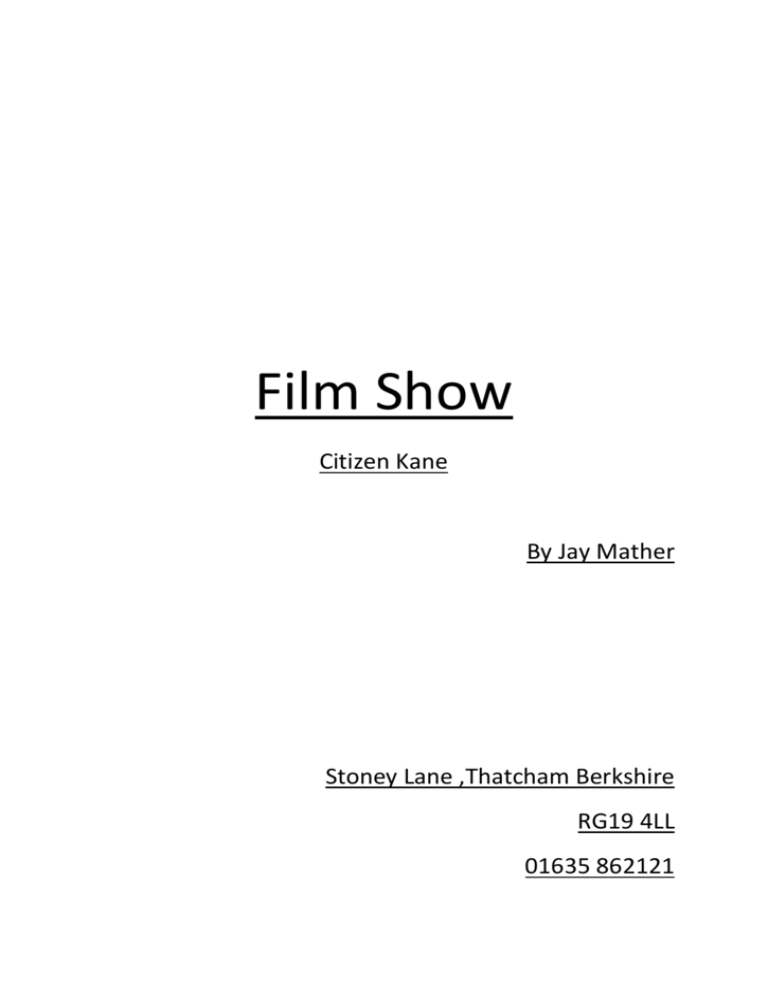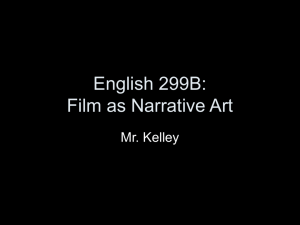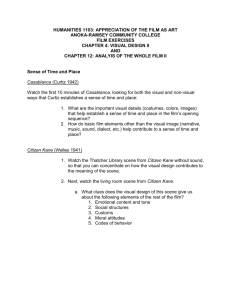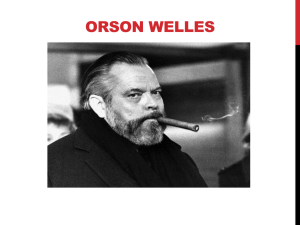Film Show Citizen Kane By Jay Mather Stoney Lane ,Thatcham
advertisement

Film Show Citizen Kane By Jay Mather Stoney Lane ,Thatcham Berkshire RG19 4LL 01635 862121 EXTREME LONGSHOT/ INT- STUDIO. SLOWLY ZOOM IN ON PRESENTER 1 STUDIO SETTING- TWO SEATS WITH PRESENTER ONE ON LEFT, 2 ON RIGHT. PRESENTER1 Hello and welcome to the show. Today we are going to review one of the most successful films in Hollywood film making history and paying close eye on its maker Orson Welles. CU/ INT. PAN TO PRESENTER 2 PRESENTER2 Citizen Kane is thought to be the best movie of all time in many movie viewing polls. Show image 1A (found in appendix) show image through the duration of the following speech Many web pages show 100% of people like it and many of them leaving comments that go on the lines of ‘it’s the greatest movie of all time’ It was the first movie that showed the full potential of editing with the great work of cinematographer Gregg Toland. CU/ INT. PAN TO PRESENTER 1 PRESENTER1 Toland’s skilful application of new and rarely used techniques proved revolutionary. He used techniques such as deep focus, low camera angles and optical illusions to help Welles create the masterpiece that is Citizen Kane. Some of the film’s innovations that had contributed to its commercial failure, including the non-linear narrative and strange and misleading conclusion, eventually set Citizen Kane apart from other films with more tradition structures and happy endings. Show image 1B (found in appendix) show image through presenter 2’s speech for 5 seconds then fade out to the presenter centred. PRESENTER2 George Orson Welles was an American director, actor, writer and producer. Born May, 1915, Welles produced only 13 full length films. He also created one of the most famous radio broadcasts to ever hit radio stations with his radio adaption of H. G. wells The War of the Worlds. Even creating panic with his fake broadcast claiming there was to be an alien attack. ECU/ INT. PAN TO PRESENTER 1 PRESENTER 1 Welles didn’t have much control when he came to the film studios in Hollywood. Welles was and individual who wanted to show off his individuality. He wanted to add his touch on the film studios by creating never before, ground breaking, nonlinear narratives. He also wanted to use his ideas and show them through camera angles that would shake up Hollywood film making for generations to come. Show images 1c+1d duration; 5 secs per image fade out to presenter 2 CU/ INT. PAN TO PRESENTER 2 PRESENTER2 Citizen finally was released in the early month of May 1941. Its reviews favoured Welles greatly but its reviews, alone, didn’t help it to reach box office stardom. After 2 years Welles re-released the film, thanks to the re-release Welles began to get the attention he deserved. CU/ INT. PAN TO PRESENTER 1 PRESENTER1 Welles had a budget of $5000, 000. This was a significant amount for an unproven filmmaker to work with, which Welles managed to exceed. The production cost hit $700,000. During this time Welles was only twenty-five. He felt a great deal of pressure when he began to work on his first featured film, Citizen Kane ECU/ INT. PAN TO PRESENTER 2 PRESENTER2 The film attracted a lot of controversy. Welles was put under radar of intimidation, blackmail, newspaper smears, discrediting and FBI investigation. Before it appeared in New York on May the 1st 1941, for its first premier. Show images 1E duration; 5 secs fade out to presenter 1. PRESENTER1 This was due to it appearing to fictionalize and caricaturize certain events and moments, powerful newspaper magnate and publisher, William Randolph Hearst had been a part of. Due to this Hearst felt a sense of invasion and made an offer to RKO pictures to destroy all the prints of the film, threatening to sue Welles and the studios. CU/ INT. CUT TO PRESENTER 2 Presenter 2 When citizen Kane was made and released, Welles faced great difficulty from the Hollywood system. The golden age sore the Hollywood Systems studios, which was created by five major studios, known as the big five, place MGM in the top spot for almost 10 years with 20th Century fox trailing in second. CU/ INT. PAN TO PRESENTER 1 PRESENTER1 In July 1939 Welles created a deal to write, direct and produce in a featured film. With this said Welles was given permission to create and develop the script, storyline and casting crew without any external interference. This was very unusual for the time as a director wasn’t normally given as much control as Welles had. Welles had complete control to do what he felt would give his vision its well deserved attention. http://www.youtube.com/watch?v=h78Lsi_6rpE SCIP TO 1:01 AND 1:26-SHOWING SOME OF WELLES’S CAMERA WORK CU/ INT. PAN TO PRESENTER 1 PRESNETER2 Although Welles seemed to have created a new way in which movies are now seen and made. Other ground breaking moments in Hollywood film making have arisen, the use of CGI came into hands of toy story makers in 1995. This was a new, innovative, step in making movies; it allowed directors and producers to release their visions a mould them into the form of computer generated animations. http://www.youtube.com/results?search_query=toy+story++1995 skip to 2;36 allow to play for 10 seconds over presenter 2’s talk on CGI EXTREME LONGSHOT/ INT- STUDIO. SLOWLY ZOOM IN ON PRESENTER 1 PRESENTER1 With such interest in the way Welles changed film making can we view Welles as an auteur? He creates the fantastic nonlinear structured storyline that shocked the whole of Hollywood. The story line that Welles choose to develop was one that would picture the life of a successful individual where in which his life was shown backwards, starting with the iconic death scene, with the muttering of the words ‘rosebud’ which would later be a mystery that the audience find themselves involved in. He was involved in all of the revolutionary camera angles positioning and movements, he did everything the way he visualized it. CU/ INT- STUDIO. CUT TO PRESENTER 2 PRSENTER2 With that said, can Welles be viewed as an auteur? The auteur theory suggests that the auteur has a view of a film that emphasizes the director, who stamps the material with his or her own personal vision, style, and intended cinematic experience. In my opinion I believe Welles is an auteur. Orson Welles was a director who is thought to be the definition of auteur, Through the use of his camera angles, lighting, and character proxemics. He frequently shoots in a closed form, with high contrast low key lighting, and uses a crane camera to create many movements within a scene. These techniques he uses, to me, all reveal a personal vision that Welles is trying to achieve. The iconic scenes such as Show image 1F (found in appendix) the following scene of a camera angle on the stage of Kane’s. Continue playing over speech This shot to me is Welles’s attempts and putting his own mark on the film by using new and inventive camera angles that picture Kane’s power. Within the shot the use of the camera angles gives off, to me, a sense of Kane’s power and political abilities and presence. It just shows Welles uses camera angles to create his visions, the way he wants it. CU/ INT- STUDIO. CUT TO PRESENTER 1 PRESENTER1 We view a director as someone who comes up with the idea, scripts it and produces it. But we now know that there is more to the world of movie production then one person. Orson Welles to me gave young generations the courage to become independent film makers and carry on the auteur role. CU/ INT- STUDIO. PAN TO PRESENTER 2 PRESENTER2 Quentin modern mark on and eye Tarantino also seems to have a habit of defining the day director. He uses violence and blood to put his his films. He gets heavily stuck into creating iconic catching camera angles. One that he is well known for is his ‘car boot shot’ http://www.youtube.com/watch?v=CxPErIjToLg shows full clip – duration 20 secs over speech of presenter 2 The car boot scene that has come iconic to Tarantino’s work, has been used in many of his films, including Pulp fiction and Kill Bill. This in my opinion puts him in clear classification as an auteur. CU/ INT- STUDIO. CUT TO PRESENTER1 PRESENTER1 Tarantino’s excessive use of blood, to me, shows what kind of movie director he is, it’s his way of stamping his mark on his film and showing what he’s about. We can see this with the use of the continuous blood splatters on marketing and advertisement attempts. Show the images 1G (found in appendix) posters of Quentin Tarantino’s work. Play over presenter The iconic blood ,not only in the poster advertisments, but in the films layered with the violence and racism is taratino’s use of icongraphy to place his mark as an auetur. CU/ INT- STUDIO. PAN TO PRESENTER2 PRESENTER2 When watching films we try and categorise them into genres by looking at the elements and Iconography involved, this is what we call Genre Theory. So what exactly is Citizen Kane? Can we actually pin point it down to an individual genre? I believe you cannot pin down the genre of such a film. During the time I believe people were soon to jump to the conclusion it was a drama, documentary. But deep analysis might suggest otherwise. CU/ INT- STUDIO. PAN TO PRESENTER2 PRESENTER1 In my opinion Citizen Kane Could be put under a sub-genre, as being a mystery. This is because of the camera angles Welles uses to capture the iconic scenes of the snow globe. http://www.youtube.com/watch?v=O4mQqVqRB7I rosebud death scene. Fade out to presenter 1 continuing talking Scenes such as the rosebud scene that show an older version of Kane dropping the snow globe, with the use of a low angle shot, the film starts with a non-linear plot. It begins to put our minds at work, trying to sort out the mystery behind the word ‘rosebud’. The snow globe also appears in several other scenes. I believe the use of the snow globe adds mystery to Kane’s life and foreshadows his pain throughout his life. The iconography of the snow globe is important in showing how Kane’s life has been a drama and full of pain and unwanted negative attention. To me this helps to give evidence and reasoning to why It could be a mystery sub-genre. CU/ INT- STUDIO. PAN TO PRESENTER2 PRESENTER2 It could easily be said that Welles’s successful attempts with Citizen Kane has changed and influenced genre, therefore influencing others to create films in the same style. Quentin Tarantino’s pulp fiction, created in 1994, along with Welles citizen Kane were both films that changed the way the public perceived the cinema and created an inspiration that would affect future directors. Like citizen Kane, pulp fiction is a character driven film but instead of Kane, in pulp fiction the viewer sees through the eyes of more than one character. They include; Vincent, Marsellus, Jules and butch. Both films could be depicted as focusing on redemption. In pulp fiction nearly all of the characters are given a chance at some kind of redemption. This could indicate it’s a crime fiction movie due to the excessive need for redemption amongst all the characters. http://www.youtube.com/watch?v=czb4jn5y94g skip to 0:56 showing all characters from Pulp Fiction. ECU SHO/ INT PRESENTER IN CENTRE. PRESENTER1 So how exactly did Citizen Kane catch the audience’s attention? How did the use of advertisement and marketing put bums on seats in cinemas? ECU SHO/ INT PAN TO PRESENTER2 IN CENTRE. PRESENTER2 Welles was limited to the amount of advertising he could do for his new masterpiece. Although a source of awareness came from an unusual source. Citizen Kane took almost 2 years to produce, but before producing Welles planned to base the story around an individual called William Randolph Hearst Show image 1 (see appendix) in centre of screen and then pan back to studio room. ECU SHO/ INT PAN TO PRESENTER1 TO THE LEFT. PRESENTER1 Hearst was an American publisher who built the nation’s largest newspaper chain. His methods influenced the way American journalism is today. Welles wanted to make Hearst the main protagonist within the film. After hearing this Hearst was furious at the thought of a film being based around his life, he wanted the studio to destroy all the negatives of citizen Kane for almost $805,000 LONG SHO/ INT JUMP TO PRESENTER 2 IN CENTER PRESENTER2 Although the film was changed to be base around Charles Foster Kane, a fictional character, similarities of Kane’s life and Hearst’s can be easily connected. With all this said there is no doubt that all the controversy and threats to sue Welles and his team created a huge source of marketing for the film. People wanted to know why Hearst was so eager to get rid of Welles’s ideas to publish this film based around him. This, with no doubt, attracted people into seeing what the fuss was all about. ECU/ INT JUMP TO PRESENTER 1 IN CENTERE PRESENTER1 When Welles first released Citizen Kane for audience viewing it didn’t get the release recognition it deserved. The attempts to market the film where based around screening viewings and reports on how Welles had created such a great masterpiece. Show reviews page (appendix image2) (5secs) over second part of speech Reviews all over the world slowly picked up the viewings, but not immediately. But revenue for marketing was created due to the positive reviews CU/ INT JUMP TO PRESENTER 2 IN CENTERE PRESENTER2 Press books were used to attract the audiences in, giving them an insight into the plot, story line, and background and production information of the film. Show press book picture (appendix image 3) (5secs) over second part of speech The use of the press books allowed Welles to engage and involve is audience by allowing them to understand more about the film before they went and watched it. This method allowed Welles to interact with the audience by giving them a sense of insight and recognition before he expected them to go and see the film in cinema. This allowed people to know what they were in for when they went to go watch his film in Theatres, across the country JUMP TO PRESENTER 1 CU/ INT IN CENTERE PRESENTER1 Quentin Tarantino, on the other hand, has used a wide range of methods to market his movies. Movies such as the big Hollywood blockbuster, Pulp fiction, used marketing methods that targeted the audience as individuals. CU/ INT PAN TO PRESENTER 2 IN CENTERE PRESENTER2 Tarantino created not just one poster, but many. Show poster images 4,5,6,7 and 8 (appendix image 4,5,6,7 and 8) (5secs each) over second part of speech Tarantino used his Hollywood actors to help promote Pulp Fiction, in his various posters. By having that celebrity endorsement, Tarantino was able to target audiences that had interests in the main stars John Travolta, Samuel L Jackson, Bruce Willis and Uma Thurman. The use of Uma Thurman laying on the bed and smoking seems to be a sneaky way of adding sex appeal to attract other kinds of audiences. CU/ INT PAN TO PRESENTER 1 IN CENTERE PRESENTER1 By creating the different posters with the appealing big stars, Tarantino was able to take into consideration, during production, the different amount of audiences he was able to attract. CU/ INT PAN TO PRESENTER 2 IN CENTERE PRESENTER2 Tarantino doesn’t stop at using posters as a source of marketing his work. When producing Django Unchained, Tarantino released screenshots of the film and used them as a chance to market his film. Show poster images 9 (appendix image9) (durating-7secs) over second part of speech In this screenshot it once again shows two well know actors Jamie Fox and Leonardo DiCaprio. These two actors were clearly enough to promote the film by itself, bringing in fans that have followed and love the actors work. CU/ INT CUT TO PRESENTER 1 IN CENTERE PRESENTER1 Tarantino’s efforts didn’t stop there he used merchandises and a wide range of DVD casing to help target different target audiences around the world. Also producing the film in 3 different languages; Chinese, Spanish and German. This was Tarantino promoting himself worldwide and succeeding in doing so. LS/ INT CUT TO PRESENTER 1 AND 2 IN CENTERE PRESENTER2 Well that concludes tonight’s show. We’ve looked at many aspects of Citizen Kane and its Producer, Orson Welles. What has been described as the greatest film of all time can no dubitably be placed in the ranks of ground breaking film making, with the use of his individuality to create such a successful film. Till next time, goodnight. Fade out into sub titles





